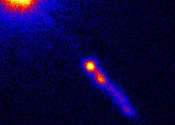Blazar LBQS 1319+0039 detected in hard X-rays
An international team of astronomers reports the detection of the blazar LBQS 1319+0039 in hard X-rays using NASA's Nuclear Spectroscopic Telescope Array (NuSTAR) space telescope. The finding, updating knowledge about this ...









